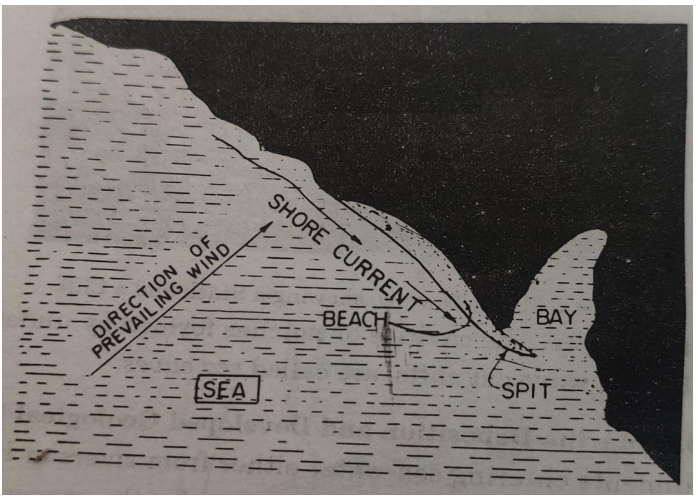Geological Work of Sea
Sea Erosion
A sea may be defined as the enormously large continuous body of water formed over depressed parts of the earth surface.
Deep seas with average depth of more than 4 km are termed as oceans. A sea is thus part of ocean which is closer to continental land
Terminology

Sea waves
Sea waves may be defined as the disturbances produced on the sea
water surface by the action of winds.
Swash wave: The part of the wave that moves forward up the beach.
Backwash wave: The part of the wave that moves back down the
beach.
Constructive wave
• Constructive waves are less powerful waves which are not so high
but having longer wavelength which roll on the beach but do not
erode it.
• Swash is stronger than backwash causing them to deposit material
on the beach.
Destructive wave
• Destructive waves are normally steep waves of high energy which
collapse almost vertically on to the shore or beach.
• Backwash is stronger than swash so they remove material from the
beach.
Bay
A small and broad inland extension of sea water where land
curves in so that sea is surrounded by land on three sides.
Gulf
The bay extending much deeper into the land is called Gulf.
Shore
Shores are relatively narrow strips of land adjacent to water
bodies. It is area immediately close to sea which is frequently
invaded by sea waves during tides is called sea shore.
Coast
Coast is a type of shore; however, coast often refers to an area
far wider than the shore, often stretching miles into the interior.
The border between land and sea on a larger scale all along the
margin of sea or ocean is known as Coast.
Section of Sea Basin

Littoral zone
This zone indicates the area between the high tide and low tide
levels. It is also known as strand. The sediments found in this
zone are coarse fragments of rock.
Continental shelf
Continental shelf starts below low tide level. It may extend from
the land to a variable distance up to about 300 km or so. The
floor shows a gentle slope. The sediments deposited in this zone
are well sorted with coarse particles in initial shallower zone
and finer particles towards the deeper end portions.
Continental slope
This zone is represented by a suddenly increased slope. The
depth variation in this zone from sea level may be from 180 m
to as much as 900 m. It is characterized by low temperature and
almost no penetration of sunlight.
Abyssal zone
This is the deepest zone marking the deep sea or the
ocean floor. It is characterized by the deposition of
finest muds of red clays. The red color of the fine
clays of this zone is primarily due to iron oxidation.
Geological work of sea
Although a sea is a reservoir of water but by virtue of its enormous dimension and the consequent generation of waves
on its surface, it acts as active agent performing geological work in form of erosion and deposition of eroded material
in sea basin.
• The advancing sea waves cause the erosion of the shore land, thus advancing the sea towards shoreline.
• The eroded sediments are then swept into the sea by retreating waves.
• The eroded material moves in suspension as well as solution.
• The suspended load when taken into the sea basin for depositing is very well sorted out by water with coarse
material deposited near the shore and finer particle taken to far off distances inside the sea.
Erosion
Transportation
Deposition
Geological work of sea is divided into following headings
Erosion
• Sea waves considerably erodes the land near the sea coast and cause extensive damage to
unprotected sea shore or to manmade structures situated near the shore.
• The erosion causes breaking, loosening and plucking out of disjointed blocks of rocks due to waves.
Abrasion
Process of constant rubbing and grinding action of sandy sea water on rocks of the shore with loosely
packed sediments or fragments of rock.
Corrosion
The solvent action of sea water erode the rocks which are soluble.
Hydraulic action
The process of breaking or loosening of the weak portions of coastal rocks under pressure exerted by sea waves.
The net result of erosion produced by these erosional processes is to considerably modify the original configuration of
the sea shore and to retreat it landward.
The extent of damage done to particular sea coast depend on composition and strength of coastal rock, slope and type
of coast, extent and fierceness of prevalent winds and that of consequently generated sea waves.
Transportation
• The movement of eroded material up and down, and along the coast is transportation.
• It has been observed that the incoming waves tends to shift the material towards the shore whereas
outgoing waves tends to carry the material towards the sea.
• The erosion or deposition depends on nature of the wave i.e it is Destructive wave or Constructive wave.
If the swash is stronger than the backwash (constructive wave), some of the sediment carried in the wave will be left behind to build up the beach. This means that the beach increases in size.
If the swash is weaker than the backwash (destructive wave), very little sediment is carried up the beach. With a strong backwash, material will be removed and the beach will decrease in size.
Deposition
• Rock particles are carried by the sea to be deposited on floors of the sea when it loses energy.
• The sediments are separated out depending on their specific gravity, shape and size.
• Coarser and heavier sediments are generally left near the coast, and the finer sediments are taken to far off places
into the deep sea.
• The sediments deposited near the shores form certain characteristic feature called shallow water deposits – beaches,
spits and bars
• The wave deposits that happens in the deep interior sea forms deep water deposit-coral reef.
Erosional landforms

Sea cliff
• A cliff is a vertical, or nearly vertical, rock exposure left at
the end of shore line due to continuous cutting into a shore
by sea waves formed due to erosion and weathering of the
exposed rock.
• Soft rock erodes quickly and forms gentle sloping cliffs,
whereas hard rock is more resistant and forms steep cliffs.
Wave cut platform
A wave cut platform is wide gentle sloping surface
found at the foot of the cliff.
Formation of wave cut platform
The sea attacks the base of the cliff between the high and
low water mark.
A wave-cut notch is formed by erosional processes such as
abrasion and hydraulic action – this is a dent in the cliff
usually at the level of high tide.
As the notch increases in size, the cliff becomes unstable
and collapses, leading to the retreat of the cliff face.
After the breakdown of the sea, cliff the materials fall down
to the base of to furnish more tools with which the waves
may batter the cliff.
The backwash carries away the eroded materials leaving
wave cut platform which has gentle seaward slope.
The process repeats and the cliff continues to retreat.
Headland and Bays

Cliffs along the coastline do not erode at the same place when a
stretch of coastline is made of alternating bands of hard rock
and soft rock arranged at right angle to the coast.
Bands of soft rocks are weaker therefore they can be eroded
quickly. This process form bays. Bays are small and broad
inland extension of sea water where land curves in so that sea is
surrounded by land on three sides.
Hard rocks is more resistant to process of erosion than soft rock
(which is eroded inwards) that leaves hard rock portion sticking
or projecting out into the sea forming headland.
Caves, arches, stacks and stumps

Cracks are formed in the headland through the
erosional processes of hydraulic action and
abrasion.
As the waves continue to grind away at the
crack, it begins to open up to form a cave.
The cave becomes larger and eventually breaks
through the headland to form an arch.
The base of the arch continually becomes wider
through further erosion, until its roof becomes
too heavy and collapses into the sea. This leaves
a stack (an isolated column of rock).
The stack is undercut at the base until it collapses
to form a stump.
Depositional landforms
Shallow water deposit
Beach
• These are deposits made near the shore from the
eroded materials due to sea waves which is generally
sorted by retreating waves that carry finer sediments
away from the shore leaving coarse sediments.
• Natural beaches may take thousands of years to
evolve, a process that is the result of constantly
moving water that erodes the land located around its
edge.
• Essentially, rocks or coral reefs located off the shore
are worn down by moving waves. Additionally, rivers
and rainwaters may erode rocks located further inland.
• These sediments are deposited along the coastline,
forming a beach.
Spits

• A spit is a stretch of sand extending from mainland
out to the sea.
• They develop where there is sudden change in the
shape of coastline.
• Normally longshore drift transport sediment along a
coastline but when the shape of coastline changes,
longshore continues to transport material in same
direction rather than following coastline.
• This results in formation of a long bank of sand
which is known as spits.
Bars

• A bar is a spit that joins together two headlands.
• The body of water behind the bar is known as lagoon.
Tombolo
A Tombolo is formed when a spit connects headland to island or island to island.

Deep water deposit
Coral Reef
• Corals are tiny sea organisms living in colonies that
secrets skeletons of limestone to form reef.
• Coral reefs are thus defined as solid structure found
in ocean that have been built from remains and
deposits of marine organisms like coral and algae.
• These deposits are formed by cementation of
skeleton of corals, shell of other attached organisms,
sediments added by the waves which results in
formation of porous limestone.
Types of Coral Reef

Fringing reef
Platform of coral formed along the margin of headland (i.e along coast)
or margins of large island.
Barrier reef
• Barrier reefs are similar to fringing reefs in that they also border a
shoreline; however, instead of growing directly out from the shore,
they are separated from land by an expanse of water.
• Barrier reef is roughly parallel to a shore and separated from it by
a lagoon or other body of water.
• The reef remains in contact with main sea water through opening in
reef barrier.
Atoll
• It is large ring shaped reefs surrounding a central lagoon.
• Atolls usually form when islands surrounded by fringing reefs sink
into the sea or the sea level rises around them.
• The fringing reefs continue to grow and eventually form circles with
lagoons inside.
Reference 1: Text book of Engineering Geology , N Chenna Kesavulu

